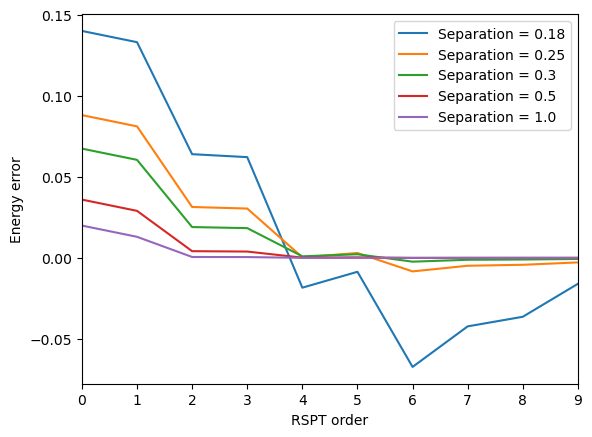Rayleigh–Schrödinger perturbation theory#
Since the Hartree–Fock state in many cases approximates the exact electronic ground state wave function quite well, it is natural to use perturbation theory as a means to improve the description. The starting point it to divide the Hamiltonian into two parts
where \(\hat{H}_0\) is some zeroth-order Hamiltonian and \(\hat{V}\) is the perturbation. The orthonormal eigenstates of \(\hat{H}_0\) are assumed to be known
The exact ground state is a solution to the time-independent Schrödinger equation
where \(| \Psi \rangle\) and \(E\) are expanded in orders of \(\hat{V}\)
Such an order-by-order procedure may converge given that \(\hat{H}_0\) includes the main features of \(\hat{H}\), and that \(\hat{V}\) in some sense is significantly smaller than \(\hat{H}_0\). We get
Collecting terms to order \(m\) gives us the master equation of Rayleigh–Schrödinger pertubation theory (RSPT)
Solving the RSPT master equation#
To zeroth order, we get
resulting in
We note that the component of \(| \Phi_0 \rangle\) in higher-order corrections \(| \Psi^{(m)} \rangle\) becomes undetermined since
We will choose \(c_0^{(m)} = 0\) such that \(\langle \Psi^{(0)} | \Psi^{(m)} \rangle = 0\) for \(m>0\). This corresponds to a choice of intermediate normalization
With this choice made, the energy corrections are easily obtained from the RSPT master equation by a projection with \(\langle \Psi^{(0)} |\):
Wave function corrections are obtained from the RSPT master equation by multiplying with the inverse and projecting out the zeroth-order solution in accordance with choice of intermediate normalization
where
Numerical illustration#
Let us set up a ten-states model of a system. This setup includes defining a diagonal zeroth-order Hamiltonian matrix, \(H_0\), and a comparatively smaller perturbation matrix, \(V\), without coupling between the ground and first excited state. The state energy separation in the unperturbed system is customizable.
import numpy as np
np.set_printoptions(precision=4, suppress=True, linewidth=132)
def setup_system(energy_separation=0.5, verbose=False, n=10):
E_0 = 1.5
Phi_0 = np.zeros(n)
Phi_0[0] = 1
H_0_diag = np.arange(E_0, E_0 + energy_separation * n, energy_separation)
H_0 = np.diag(H_0_diag)
np.random.seed(20220526)
V = -0.1 * np.diag(np.random.rand(n) * 0.1)
for i in range(2, n):
V[i - 2 : i, i] = np.random.rand(2) * 0.25
V = V + V.T
H = H_0 + V
eigval, _ = np.linalg.eigh(H)
E_exact = eigval.min()
# M = P * (H_0 - E_0)^{-1} * P
M_diag = H_0_diag - E_0
M_diag[0] = 1
M = np.diag(1 / M_diag)
M[0, 0] = 0
E = [E_0]
Psi = [Phi_0]
if verbose:
print(H)
return E_exact, E, Psi, V, M
For a given system, the RSPT equations are solved to determine the energy up to a given order. In a first example, we consider a system where the separation energy is 0.50 and equals twice the maximum perturbation energy of 0.25.
E_exact, E, Psi, V, M = setup_system(energy_separation=0.5, verbose=True, n=10)
[[1.4931 0. 0.1577 0. 0. 0. 0. 0. 0. 0. ]
[0. 1.9948 0.2499 0.0431 0. 0. 0. 0. 0. 0. ]
[0.1577 0.2499 2.4836 0.1796 0.2426 0. 0. 0. 0. 0. ]
[0. 0.0431 0.1796 2.9848 0.1341 0.2125 0. 0. 0. 0. ]
[0. 0. 0.2426 0.1341 3.4843 0.2393 0.0742 0. 0. 0. ]
[0. 0. 0. 0.2125 0.2393 3.9982 0.1831 0.0795 0. 0. ]
[0. 0. 0. 0. 0.0742 0.1831 4.492 0.2116 0.2425 0. ]
[0. 0. 0. 0. 0. 0.0795 0.2116 4.9965 0.1532 0.0945]
[0. 0. 0. 0. 0. 0. 0.2425 0.1532 5.4865 0.2328]
[0. 0. 0. 0. 0. 0. 0. 0.0945 0.2328 5.9925]]
def rspt_solver(E_exact, E, Psi, V, M, verbose=False):
error = [E[0] - E_exact]
if verbose:
print(" n RSPT energy Error")
print(f" 0 {E[0]:12.8f} {error[0]:14.8f}")
for m in range(1, 10):
E.append(np.einsum("i,ij,j", Psi[0], V, Psi[m - 1]))
error.append(np.array(E).sum() - E_exact)
R = np.einsum("ij,j->i", V, Psi[m - 1])
for k in range(1, m):
R -= E[k] * Psi[m - k]
Psi.append(np.einsum("ij,j->i", -M, R))
if verbose:
print(f"{m:2} {np.array(E).sum():12.8f} {error[-1]:14.8f}")
return E, error
_ = rspt_solver(E_exact, E, Psi, V, M, True)
n RSPT energy Error
0 1.50000000 0.03590812
1 1.49306122 0.02896934
2 1.46820039 0.00410850
3 1.46796433 0.00387245
4 1.46420937 0.00011749
5 1.46437373 0.00028185
6 1.46401910 -0.00007279
7 1.46407353 -0.00001836
8 1.46407816 -0.00001372
9 1.46408390 -0.00000798
Convergence of the ground state energy is reasonably smooth with significant increases in accuracy occurring at even orders in perturbation theory.
In a next illustration, we will study how the convergence depends on the state energy separation.
import matplotlib.pyplot as plt
for energy_separation in [0.18, 0.25, 0.3, 0.5, 1.0]:
E_exact, E, Psi, V, M = setup_system(energy_separation, False, 10)
E, error = rspt_solver(E_exact, E, Psi, V, M, False)
plt.plot(range(10), error, label=f"Separation = {energy_separation:.2}")
plt.legend()
plt.setp(plt.gca(), xlim=(0, 9), xticks=range(10))
plt.ylabel("Energy error")
plt.xlabel("RSPT order")
plt.show()

As clearly seen, the convergence rate and even success depends critically on the state energy separation. This is due to the fact the a smaller energy separation leads to larger inverse matrix in the RSPT equation from which we determine the state vector correction \( |\Psi^{(m)} \rangle\).
Size extensivity in RSPT#
A system composed of two noninteracting subsystems has a Hamiltonian that is separable
where, in the last step, identity operators are left out and implicitly understood.
Zeroth- and first-order energies#
We assume that the unperturbed Hamiltonian (and thereby also the perturbation) is chosen as to also be separable. The zeroth-order wave function becomes
and the associated zeroth-order energy reads
For the first-order energy correction, we straightforwardly get
Second-order energy#
The first-order wave function becomes
Operators and energies within parenthesis are separable but we need to investigate the effect of the inverse operation.
Let us introduce \(\hat{\Omega}_A = \hat{H}_{0;A} - E^{(0)}_{A}\) and use the identity
For the first of these two terms, we get
whereas for the second, we get
since
Collecting results for the two subsystems, the first-order correction to the wave function becomes
and the second-order correction to the energy is thereby shown to fulfill
In other words, RSPT has been shown to be size-extensive up to second order in perturbation theory.
